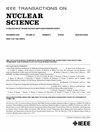Xilinx FPGA 嵌入式多千兆位收发器中用于时钟分配和同步的延迟不稳定性研究
IF 1.9
3区 工程技术
Q3 ENGINEERING, ELECTRICAL & ELECTRONIC
引用次数: 0
摘要
赛灵思现场可编程门阵列(FPGA)的千兆位收发器(MGT)已被广泛用于物理实验中时钟分配和同步系统的实施。所提出的解决方案通常基于从串行流中恢复的时钟信号。然而,由于 FPGA 中 MGT 的主要目的是实现高速数据传输,因此没有充分考虑延迟稳定性,尤其是初始化/复位操作后的延迟稳定性。Xilinx MGT 可以灵活配置为不同的模式。由于赛灵思没有充分说明每种模式的实现结构,因此必须通过实验研究延迟特性,以实现高性能的时钟传输。本文对 Xilinx MGT 的延迟不稳定性进行了全面研究,并提出了尽量减少延迟不稳定性的对策,以实现稳定的时钟和数据传输。此外,还提出了一种方法,可直接从 Xilinx UltraScale 和更高级别的 FPGA 获取高质量的恢复时钟,从而无需使用片外抖动清除器。测试结果表明,一旦延迟不稳定性问题得到妥善解决,基于 MGT 的串行链路就能实现较高的时钟分配和同步性能。本文章由计算机程序翻译,如有差异,请以英文原文为准。
Study of Delay Instabilities in Xilinx FPGA-Embedded Multigigabit Transceivers for Clock Distribution and Synchronization
Multigigabit transceivers (MGTs) of Xilinx field-programmable gate arrays (FPGAs) have been widely investigated for the implementation of clock distribution and synchronization systems in physics experiments. Often, the proposed solutions are based on the clock signal recovered from the serial stream. However, since the main purpose of MGTs in FPGA is to achieve high-speed data transmission, the delay stability, especially after initialization/reset operations, is not sufficiently considered. The Xilinx MGTs can be configured in different modes for flexibility. Since Xilinx does not fully explain the implementation structure of each mode, the delay characteristics must be investigated experimentally to achieve high-performance clock transmission. This article presents a comprehensive investigation of the delay instabilities in Xilinx MGTs and proposes countermeasures to minimize them for stable clock and data transmission. In addition, a method is proposed to obtain a high-quality recovered clock directly from Xilinx UltraScale and higher-level FPGAs, eliminating the need for an off-chip jitter cleaner. The test results indicate that high clock distribution and synchronization performance can be achieved over the MGT-based serial link once the delay instabilities are properly addressed.
求助全文
通过发布文献求助,成功后即可免费获取论文全文。
去求助
来源期刊

IEEE Transactions on Nuclear Science
工程技术-工程:电子与电气
CiteScore
3.70
自引率
27.80%
发文量
314
审稿时长
6.2 months
期刊介绍:
The IEEE Transactions on Nuclear Science is a publication of the IEEE Nuclear and Plasma Sciences Society. It is viewed as the primary source of technical information in many of the areas it covers. As judged by JCR impact factor, TNS consistently ranks in the top five journals in the category of Nuclear Science & Technology. It has one of the higher immediacy indices, indicating that the information it publishes is viewed as timely, and has a relatively long citation half-life, indicating that the published information also is viewed as valuable for a number of years.
The IEEE Transactions on Nuclear Science is published bimonthly. Its scope includes all aspects of the theory and application of nuclear science and engineering. It focuses on instrumentation for the detection and measurement of ionizing radiation; particle accelerators and their controls; nuclear medicine and its application; effects of radiation on materials, components, and systems; reactor instrumentation and controls; and measurement of radiation in space.
 求助内容:
求助内容: 应助结果提醒方式:
应助结果提醒方式:


